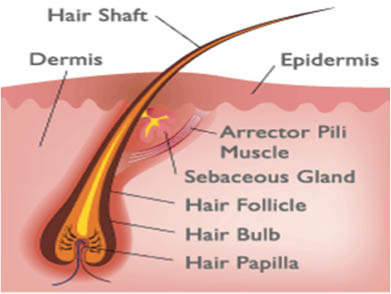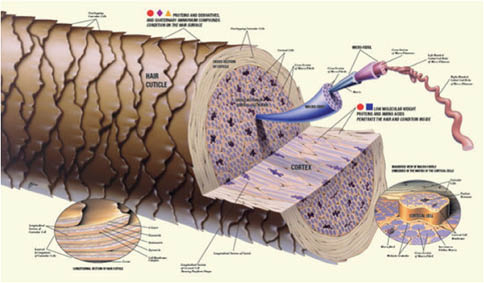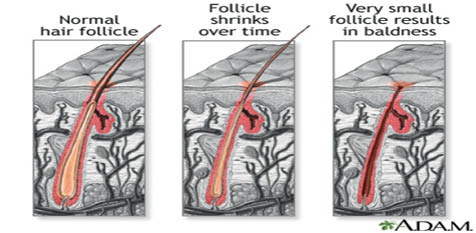AND REPAIR
Padmaja Prem, Ph.D
Vice President, Research & Development
Combe Incorporated, 1101 Westchester Avenue
White Plains, NY 10604
ABSTRACT
Aging skin is a concept easily grasped; aging hair is not. However, changes in hair with aging are consumer perceivable and measurable. This chapter describes the structure of hair, fundamentals of aging hair, signs of aging hair, and causes of the visible signs of aging hair. Further, it also covers remedies for protection of hair fibers, the scalp from which it grows, as well as hair products and ingredients formulated to maintain and restore youthful hair. Beyond these approaches, the author has also provided a unique cosmeticological look at selected products and ingredients on the market with commentary on their performance.
While considerable attention has been paid to the many factors affecting aging skin, it is only recently that a shift in the perception that hair is “dead” has begun to accelerate. Actually, while this is true, in part, it is also true that the core of the hair fibers is alive as well as the skin from which it grows, and much has been done and needs doing to bring it to life again.
The understanding of the hair-scalp system described in this chapter provides important leads to ingredient-seekers and product formulators and presents an opportunity for a myriad of novel products that consumers long for. The chapter is also unique in that it provides thoughtful, practical recommendations for hair care and protection. This wisdom goes beyond the traditional approach of finding new ingredients or formulations to achieve the goals of beautiful hair. It is recommended that these approaches be incorporated in recommendations by product manufacturers as important information to consumers.
3.3.3.2 Structure, Composition, and Natural Color of Hair
3.3.3.3 Fundamentals and Signs of Aging Hair
3.3.3.5 Protection of Hair from Aging
3.3.3.6 Anti-Aging Hair Care Products
Similar to skin, with aging, the scalp and hair are subject to intrinsic or chronological aging, and extrinsic aging due to environmental factors. The changes associated with aging skin and the mechanism of skin aging has been well researched and published extensively over the past decades. According to Mintel’s global product database, nearly half of the skin care products in the market are anti-aging products.
While the aging of hair has not been studied extensively like skin aging, there are numerous studies published on hair aging1–3, and the number of anti-aging hair care products continues to increase year by year4. The most obvious sign of hair aging is the appearance of gray hair that correlates closely with intrinsic aging. Melanin pigment is responsible for the natural color of hair and it is produced by melanocytes in the hair follicles. With aging, melanocytes stop producing melanin pigment, resulting in gray hair. The loss of melanin has been linked to a decrease in the number of melanocytes in the hair follicle as well as a possible decrease in the activity of the enzymes involved in melanogenesis5. A recent publication by Wood et al.6 showed for the first time high accumulation of hydrogen peroxide in human gray scalp hair shaft, thus supporting the theory of oxidative stress in gray hair formation. These researchers also demonstrated that H2O2-mediated oxidation of methionine in tyrosinase enzyme limits its functionality, which leads to gradual loss of hair color.
In addition to graying of hair, with aging, your hair will become deficient in essential nutrients and the hair follicles shrink, it loses its elasticity, lipid and keratin production diminish, and many hair follicles stop producing new hairs altogether. These internal changes cause hair to become thin, dry, less manageable, brittle and less shiny, and ultimately lead to hair fall.
Externally, the hair shaft is exposed to sunlight, environmental pollutants, chemical and heat treatments, and subjected to daily grooming and mechanical aggression-in-search-of- “beauty.” These environmental insults and daily aggressors alter the chemical and physical properties of the hair fiber. When hair is exposed to sunlight, severe damage occurs due to lipid, protein, and melanin oxidation. This results in loss of mechanical strength, loss of color, an increase in porosity, as well as an increase in surface roughness. Other environmental pollutants such as cigarette smoke, car exhaust fumes, and smog also impart hair damage, resulting in dull and brittle hair. These physicochemical changes in hair structure and damage caused by aging are measurable and also perceivable to the consumer.
Several methods involving microscopic techniques, differential scanning calorimetric, wet and dry combing measurements, protein loss, and assessment of tensile properties of the hair are generally used to evaluate the various physicochemical changes to hair7. These approaches are useful in characterizing aging changes as well as the effect of “treatments” that may improve the detrimental effects of the various stressors.
Hair loss is another significant aspect of aging that occurs gradually with a progressive thinning of hair. With aging, less protein is produced in the hair follicle that can cause hair to fall out and not to be replaced as quickly as desirable. This causes baldness, as well as thinning of hair. Unlike the long term, initial focus on the skin of women, the baldness phenomenon is also a men’s “condition” and any impact of novel approaches to reduce hair loss and hair thinning represents an area of potential product growth for both men and women.
Experimental evidence supports the hypothesis that oxidative stress also plays a role in hair aging. The damaging effects of these reactive oxygen species are induced internally during normal metabolism and externally through exposure to various oxidative stresses from the environment. The body possesses endogenous defense mechanisms, such as antioxidant enzymes (superoxide dismutase, catalase, glutathione peroxidase) and non-enzymatic antioxidative molecules (e.g., vitamin E, vitamin C, glutathione, ubiquinone), protecting it from free radicals by reducing and neutralizing them.9 With age, the production of free radicals increases, while the endogenous defense mechanisms decrease. This imbalance leads to the progressive damage of cellular structures, presumably resulting in the aging phenotype.
Nourishment and proper grooming are very important to maintain the beauty of hair as perceived by: good hair texture, healthy growth, shine, and luster. Eating foods rich in vitamin A, B, minerals, and proteins is necessary for promoting a healthy scalp and hence healthy hair growth. Eating a diet rich in dark green vegetables, orange and yellow fruits, sprouted whole grains, cereals, meat, and soy helps maintain a healthy follicle. It is equally important to use good scalp care and hair care products to protect the hair shaft from damage due to sunlight, pollution, and other daily aggressors. For daily washes, use a shampoo that is mild, gentle, and moisturizing. Anti-aging hair care topical and ingestible products enriched with vitamins, lipids, proteins, vegetable oils, and antioxidant rejuvenate the scalp and follicle, and encourage new, more resilient growth from the root.
This chapter describes the fundamentals of aging hair, signs of aging hair, and the causes of visible signs of aging. Further, it also surveys current remedies for protection of the hair fiber, along with hair products formulated to maintain and restore youthful hair.
3.3.3.2 STRUCTURE, COMPOSITION,
AND NATURAL COLOR OF HAIR
Hair is composed of two parts, the hair follicle and the hair shaft. The hair follicle is a tiny cup-shaped point located in the dermis from which the hair grows. The hair follicle consists of the hair bulb, the inner root sheath, and the hair shaft (see Figure 1).

Figure 1. Cross-Sectional Image of Hair Bulb Structure
New hair is made inside the onion-shaped hair bulb that lies within the hair follicle. The hair bulb also contains some special cells called melanocytes that produce melanin, the pigment responsible for the natural color of hair. The part of the hair seen above the scalp is called the hair shaft. It consists of three layers; cuticle, cortex, and medulla (see Figure 2).

Figure 2. Structure of Human Hair Fiber
The outermost layer called cuticle is a thin and colorless layer made of several overlapping scale-type structures. It is responsible for the visual attributes of hair such as shine and smoothness. It is also responsible for the friction effect of hair, which determines manageability (i.e., how easy it is to comb or brush hair). The cuticle layer can be damaged by daily grooming such as combing and brushing as well as by chemical treatments such as bleaching or relaxing. The middle layer of the hair shaft is called the cortex, made of keratin fibers. The strength, color, and texture of a hair fiber are provided by the cortex. The innermost layer of the hair shaft called medulla is only present in large and thick hairs.
Melanocytes are the cells responsible for the natural color of hair, which are large star-shaped cells with branches called dendrites. They are mainly found at the bottom of the hair follicle, where they produce melanin in the form of small grains of colored pigment. Melanocytes inject these pigments into the keratinocytes of the hair shaft by lengthening their dendrites. Melanocyte produces two types of melanin: eumelanin and phaeomelanin. Eumelanin occurs in the form of a small rice-like granule having a color varying between brown and black. Melanin is formed by the oxidation of an amino acid, tyrosine by the enzyme tyrosinase. The higher the concentration of eumelanin, the darker the color of hair.
The actual appearance of hair, and its overall reflective quality, is determined primarily by the pigment type, but also by the density and distribution of the pigment granules. Phaeomelanin has a less precise shape and can be seen in the form of diffuse spots. Its color varies from yellow to red. Phaeomelanin differs from eumelanin because, in addition to tyrosine, another amino acid, rich in sulfur (cysteine), is involved in its production. There are two different types of eumelanin (brown eumelanin and black eumelanin). A small amount of brown eumelanin in the absence of other pigments apparently causes blond hair.
Although people with dark hair may still produce the yellow-orange pheomelanin, it is largely masked by the dark eumelanin pigment and cannot easily be seen. However, the red-yellow pheomelanin is believed to cause the warm, golden, or auburn tones found in some types of brown hair. The range of colors produced by melanins is limited to shades of yellow, brown, red, and black. Gray hairs contain only a few melanin granules, spread throughout the hair. White hairs contain no melanin at all: their whiteness is an optical effect, due to the way they reflect the light.
3.3.3.3 FUNDAMENTALS AND SIGNS OF AGING HAIR
When considering the phenomenon of hair aging, genetic, hormonal, and environmental factors need to be taken into account. Similar to skin, the scalp and hair are subject to intrinsic aging depending on individual genetics and hormonal factors and extrinsic aging due to environmental factors. Intrinsic aging or chronological aging results in graying of hair due to a decrease in melanin production and loss of hair due to androgenic alopecia. Extrinsic factors include ultraviolet radiation, pollution, smoking, diet, and lifestyle. All these extrinsic factors progressively degrade the hair fiber through oxidation of lipids, cleavage of disulfide bond, degradation of amino acids, and oxidation/bleaching of melanin pigment.
The effects of age-related changes in hair density, hair diameter, hair lipids, and hair color (graying) produce changes in hair fiber properties. These changes in properties impact important consumer hair assembly properties such as ease of combing, hair body, hair coverage, frizziness, shine, manageability, and style retention. There are many visible signs of aging hair that are measurable and consumer perceivable. The most critical aging attributes are thinning of hair, loss of color, moisture, shine, and manageability.
Thinning of Hair
Both men and women tend to lose hair thickness and amount as they age. Baldness is not usually caused by a disease. It has been found that poor diet, stress, aging, and pollution are the most common factors that damage hairs and cause hair loss. Scientifically, health experts have found that the growth of dihydrotestosterone (DHT) hormone on the scalp is responsible for hair loss. With aging, hair loss is experienced more rapidly because the amount of DHT increases with increase in age. This hormone makes hair follicles weaker and weaker by blocking the nutrients and water to the hairs. Over time, the follicle can shrink, causing the hair to become shorter and finer and finally the hairs fall from the scalp. Figure 3 shows the picture of a normal hair follicle compared to a finer follicle and a very small hair follicle, which results in baldness.

Figure 3. Picture of a hair follicle showing shrinkage over time
According to the American Hair Loss Association, around two-thirds of U.S. men will have experienced some degree of hair loss by the age of 35, and about 85% of men will have significantly thinning hair by the age of 50. Although hair loss is typically associated with men, figures state that women make up 40% of all hair loss sufferers in the U.S., showing that hair loss is a condition that can affect us all. Recent studies claim that 16% of women under age 50 are affected, which increases to 30–40% of women aged 70 years and over10. The thinning of hair in women may become rather more pronounced after menopause when there are fewer estrogen hormones to counteract the androgens. Men tend to have baldness while women have thinning of hair and preservation of the frontal area.
Hair loss treatment products are mostly designed to act as DHT blockers. In recent years, two pharmacological agents have become available to treat male pattern baldness. Neither is fully effective in all cases. Both need long-term administration or there will be recurrence. Both must be prescribed on private prescription. Minoxidil is provided in 2% and 5% solutions that are applied to the scalp twice daily. The 5% solution is for men only. One study found that the 5% solution was 45% more effective than the weaker strength after a 48-week trial and was the preferred treatment for men11. It may well be months before any improvement is seen and it should be discontinued if there is none after a year. A solution of 5% minoxidil in cutaneous foam is now available, which is developed for ease of use. The product instruction requires application of half a capful to the scalp twice a day but the treatment should be stopped if there is no improvement after four months.
Recently, the natural hair loss treatment, Provillus™
Stay updated, free articles. Join our Telegram channel

Full access? Get Clinical Tree








